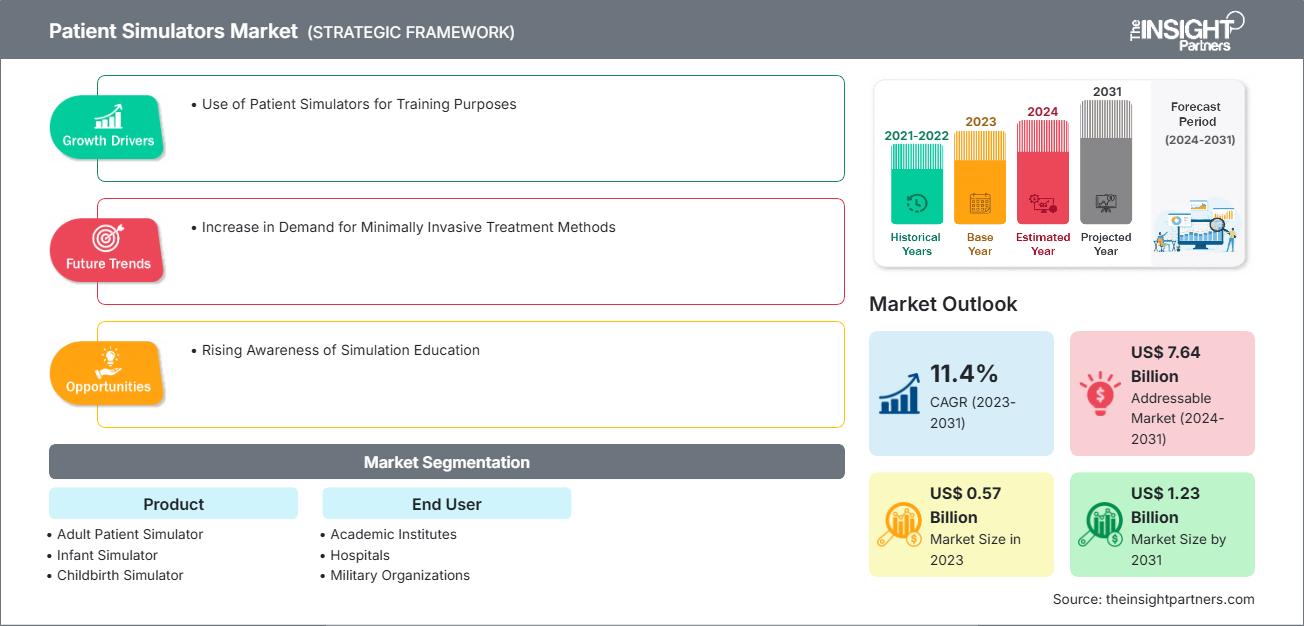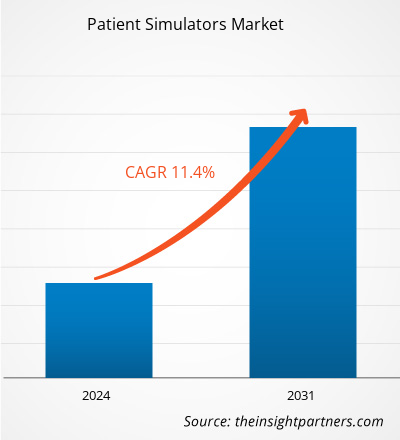Der Markt für Patientensimulatoren wird Prognosen zufolge bis 2031 ein Volumen von 1,23 Milliarden US-Dollar erreichen, gegenüber 0,57 Milliarden US-Dollar im Jahr 2023. Es wird erwartet, dass der Markt im Zeitraum 2023–2031 eine durchschnittliche jährliche Wachstumsrate (CAGR) von 11,4 % verzeichnen wird. Die fortschreitende technologische Entwicklung bei Patientensimulatoren dürfte weiterhin ein wichtiger Trend auf dem Markt bleiben.
Marktanalyse für Patientensimulatoren
Zu den wichtigsten Wachstumstreibern des Marktes zählen die steigende Nachfrage nach Patientensimulatoren für die Ausbildung von medizinischem Fachpersonal sowie der zunehmende Bedarf an minimalinvasiven Behandlungsmethoden. Die hohen Kosten von Patientensimulatoren dürften das Marktwachstum im Prognosezeitraum jedoch bremsen. Gleichzeitig eröffnet das wachsende Bewusstsein für die Bedeutung von Simulationstrainings neue Wachstumschancen für den Markt für Patientensimulatoren im kommenden Prognosezeitraum.
Marktübersicht Patientensimulatoren
Patientensimulationen ermöglichen es medizinischem Fachpersonal und Studierenden, die in ihren jeweiligen Fachgebieten erforderlichen technischen und beruflichen Fähigkeiten ohne die Risiken der Behandlung von Patienten zu entwickeln. Trainingsmodelle bieten nicht nur praktische Übungsmöglichkeiten, sondern auch eine hervorragende visuelle Darstellung. Die hochrealistischen Simulatoren erfassen und visualisieren Puls, Atmung, Herzrhythmus und Blutdruck – genau wie bei echten Patienten. Diese Funktionen sprechen die Lernenden emotional an und schaffen eine realistische Lernumgebung, in der sie sich intensiv mit der Übung auseinandersetzen und den simulierten Patienten genauso behandeln können wie einen echten. Der Einsatz simulationsbasierter Trainingsinstrumente in der Chirurgie nimmt rasant zu und hat sich als vorteilhafte Alternative zu herkömmlichen Trainingsmethoden erwiesen, die trotz des hohen Arbeitsdrucks die Verbesserung chirurgischer Fähigkeiten ermöglichen. Die Simulation spielt eine zentrale Rolle in der Ausbildung von Fachkräften im Gesundheitswesen. Simulationsbasiertes Training kann ein Expertenteam zu einem echten Expertenteam formen. Daher treibt der zunehmende Einsatz von Simulatoren in Lehrkrankenhäusern, Pflegeschulen, der militärischen Sanitätsausbildung und Rettungssanitäterausbildungszentren den Markt für Patientensimulatoren an.
Passen Sie diesen Bericht Ihren Anforderungen an.
Sie erhalten eine kostenlose Anpassung aller Berichte – einschließlich Teilen dieses Berichts, Länderanalysen und Excel-Datenpaketen – sowie attraktive Angebote und Rabatte für Start-ups und Universitäten.
Markt für Patientensimulatoren: Strategische Einblicke

-
Ermitteln Sie die wichtigsten Markttrends dieses Berichts.Diese KOSTENLOSE Probe beinhaltet eine Datenanalyse, die von Markttrends bis hin zu Schätzungen und Prognosen reicht.
Markttreiber und Chancen für Patientensimulatoren
Zunehmende Nachfrage nach minimalinvasiven Behandlungsmethoden
Minimalinvasive medizinische Eingriffe werden in der Regel durchgeführt, indem das Gerät durch die Haut, eine Körperhöhle oder eine anatomische Öffnung in den Körper eingeführt wird, wobei die Strukturen so wenig wie möglich geschädigt werden. In den letzten Jahren wurden bedeutende Fortschritte in der Behandlung von Herz-Kreislauf-Erkrankungen erzielt. Diese komplexen Eingriffe erfordern jedoch umfassende Erfahrung und technisches Fachwissen. Simulatoren erleichtern die komplexe Behandlung von Herz-Kreislauf-Erkrankungen. Das System kann realistische 3D-Gefäßmodelle, segmentiert aus Patientendatensätzen, einschließlich eines schlagenden Herzens, erstellen und bietet eine Echtzeit-Kraftberechnung sowie ein Kraftrückkopplungsmodul für Patientensimulatoren. Darüber hinaus gewinnt die roboterassistierte minimalinvasive Chirurgie (MIS) zunehmend an Akzeptanz. Der Bedarf an Weiterbildungen für Assistenzärzte in dieser Operationstechnik wächst. Die steigende Nachfrage nach MIS treibt das Wachstum des Marktes für Patientensimulatoren an.
Zunehmendes Bewusstsein für Simulationspädagogik
Verschiedene Organisationen führen diverse Aktivitäten zur Sensibilisierung für Patientensimulationen durch. So wurde beispielsweise 2007 die Lateinamerikanische Gesellschaft für Simulation im Gesundheitswesen (ALASIC) gegründet, um die Zusammenarbeit und Vernetzung von Mitgliedern aus verschiedenen nord-, mittel- und südamerikanischen Ländern auf dem Kontinent zu fördern. Angesichts der Bedeutung der Patientensicherheit eröffnen auch viele Universitäten Patientensimulationszentren. Ständig werden in den USA und weltweit neue Simulationszentren im Gesundheitswesen eröffnet.
Die Simulationszentren verfügen über spezialisierte, ausgebildete Ärzte, hochentwickelte, computergesteuerte Simulationspuppen aller Altersgruppen und realitätsnahe Simulationsbedingungen, um Studierenden und medizinischem Fachpersonal das Üben klinischer Fertigkeiten zu ermöglichen. Diese Trainingszentren fördern zudem Kommunikations- und Entscheidungsfähigkeiten und bieten praxisnahe Schulungen in medizinischer Diagnose, Behandlung und Pflege. Schätzungsweise werden dadurch über 50.000 Stunden praktisches Lernen für fast 20.000 Lernende ermöglicht, die in den Gesundheitswissenschaften arbeiten oder eine Karriere in diesem Bereich anstreben. Das wachsende Bewusstsein für Simulationsausbildung dürfte somit dem Markt für Patientensimulationen neue Chancen eröffnen.
Marktbericht für Patientensimulatoren: Segmentierungsanalyse
Die wichtigsten Segmente, die zur Ableitung der Marktanalyse für Patientensimulatoren beigetragen haben, sind Produkt und Endnutzer.
- Basierend auf dem Produkt ist der Markt für Patientensimulatoren in Erwachsenen-Patientensimulatoren, Säuglingssimulatoren und Geburtssimulatoren unterteilt. Das Segment der Erwachsenen-Patientensimulatoren hatte 2023 den größten Marktanteil.
- Basierend auf den Endnutzern ist der Markt für Patientensimulatoren in akademische Einrichtungen, Krankenhäuser und militärische Organisationen unterteilt. Das Segment der akademischen Einrichtungen hielt 2023 den größten Marktanteil.
Marktanteilsanalyse für Patientensimulatoren nach Regionen
Der geografische Umfang des Marktberichts für Patientensimulatoren ist hauptsächlich in fünf Regionen unterteilt: Nordamerika, Asien-Pazifik, Europa, Naher Osten & Afrika sowie Süd- & Mittelamerika.
In Nordamerika sind die USA der größte Markt für Patientensimulatoren. Diese werden von zahlreichen Herstellern und Ausbildungseinrichtungen für Schulungszwecke eingesetzt. Beispielsweise ist das Johns Hopkins Medicine Simulation Center eine moderne, voll akkreditierte medizinische Ausbildungsstätte, die verschiedene Simulationstechniken nutzt, darunter computergestützte Simulationen, Virtual Reality, Task-Trainer, Patientensimulationen sowie standardisierte Patienten und Lehrassistenten. Die Verbesserung der Patientensicherheit ist das Hauptziel des Zentrums. Diese Trainingseinrichtungen stärken das Sicherheitsgefühl und die Reaktionsfähigkeit von Klinikern in Notfällen und tragen gleichzeitig zur Erhöhung der Patientensicherheit bei.
Die oben genannten Statistiken zu Todesfällen aufgrund von Behandlungsfehlern sowie die Maßnahmen zur Einbeziehung des Einsatzes von Patientensimulatoren zu Ausbildungszwecken dürften die Nachfrage nach Patientensimulatoren in den USA im Prognosezeitraum erheblich steigern.
Markt für Patientensimulatoren – Regionale Einblicke
Die regionalen Trends und Einflussfaktoren auf den Markt für Patientensimulatoren im gesamten Prognosezeitraum wurden von den Analysten von The Insight Partners eingehend erläutert. Dieser Abschnitt behandelt außerdem die Marktsegmente und die geografische Verteilung des Marktes für Patientensimulatoren in Nordamerika, Europa, Asien-Pazifik, dem Nahen Osten und Afrika sowie Süd- und Mittelamerika.
Umfang des Marktberichts zu Patientensimulatoren
| Berichtattribute | Details |
|---|---|
| Marktgröße im Jahr 2023 | 0,57 Milliarden US-Dollar |
| Marktgröße bis 2031 | 1,23 Milliarden US-Dollar |
| Globale durchschnittliche jährliche Wachstumsrate (2023 - 2031) | 11,4 % |
| Historische Daten | 2021-2022 |
| Prognosezeitraum | 2024–2031 |
| Abgedeckte Segmente |
Nebenprodukt
|
| Abgedeckte Regionen und Länder |
Nordamerika
|
| Marktführer und wichtige Unternehmensprofile |
|
Marktdichte der Patientensimulatoren: Auswirkungen auf die Geschäftsdynamik verstehen
Der Markt für Patientensimulatoren wächst rasant, angetrieben durch die steigende Nachfrage der Endnutzer. Gründe hierfür sind unter anderem sich wandelnde Verbraucherpräferenzen, technologische Fortschritte und ein wachsendes Bewusstsein für die Vorteile des Produkts. Mit steigender Nachfrage erweitern Unternehmen ihr Angebot, entwickeln innovative Lösungen für die Bedürfnisse der Verbraucher und nutzen neue Trends, was das Marktwachstum zusätzlich beflügelt.

- Überblick über die wichtigsten Akteure im Markt für Patientensimulatoren
Marktneuigkeiten und aktuelle Entwicklungen im Bereich Patientensimulatoren
Der Markt für Patientensimulatoren wird anhand qualitativer und quantitativer Daten aus Primär- und Sekundärforschung analysiert. Diese umfasst wichtige Unternehmensveröffentlichungen, Verbandsdaten und Datenbanken. Einige Entwicklungen auf dem Markt für Patientensimulatoren sind nachfolgend aufgeführt:
- GigXR Inc. und CAE Healthcare haben eine Partnerschaft geschlossen, um die Effizienz und Effektivität klinischer Simulationen zu steigern. Die Zusammenarbeit zwischen GigXR und CAE Healthcare vereinfacht die Implementierung und das Management multimodaler Simulationen für medizinische Fakultäten, Pflegeschulen, Krankenhäuser, Rettungsdienste und Behörden – von analogen über immersive bis hin zu digitalen Modalitäten, die zur Erstellung vollständiger Curricula genutzt werden können. (Quelle: CAE Healthcare, Unternehmenswebsite, Januar 2024)
- Laerdal Medical und SimX schließen eine Partnerschaft, um die Wirkung von VR-basierten medizinischen Simulationstrainings zu verstärken. Im Rahmen dieser Partnerschaft wird Laerdal zum Hauptvertriebspartner der SimX-Virtual-Reality-Simulationsplattform für Krankenhäuser, Rettungsdienste und Behörden in den USA und Kanada. (Quelle: Laerdal Medical, Unternehmenswebsite, Juni 2022)
Marktbericht zu Patientensimulatoren: Abdeckung und Ergebnisse
Der Bericht „Marktgröße und Prognose für Patientensimulatoren (2021–2031)“ bietet eine detaillierte Analyse des Marktes und deckt folgende Bereiche ab:
- Marktgröße und Prognose für Patientensimulatoren auf globaler, regionaler und Länderebene für alle wichtigen Marktsegmente, die im Geltungsbereich abgedeckt werden.
- Markttrends für Patientensimulatoren sowie Marktdynamiken wie Treiber, Hemmnisse und wichtige Chancen
- Detaillierte PEST-/Porter-Fünf-Kräfte- und SWOT-Analyse
- Marktanalyse für Patientensimulatoren mit Fokus auf wichtige Markttrends, globale und regionale Rahmenbedingungen, Hauptakteure, regulatorische Bestimmungen und aktuelle Marktentwicklungen.
- Branchenlandschaft und Wettbewerbsanalyse mit Fokus auf Marktkonzentration, Heatmap-Analyse, führende Akteure und aktuelle Entwicklungen im Markt für Patientensimulatoren
- Detaillierte Unternehmensprofile
- Historische Analyse (2 Jahre), Basisjahr, Prognose (7 Jahre) mit CAGR
- PEST- und SWOT-Analyse
- Marktgröße Wert/Volumen – Global, Regional, Land
- Branchen- und Wettbewerbslandschaft
- Excel-Datensatz
Aktuelle Berichte
Erfahrungsberichte
Grund zum Kauf
- Fundierte Entscheidungsfindung
- Marktdynamik verstehen
- Wettbewerbsanalyse
- Kundeneinblicke
- Marktprognosen
- Risikominimierung
- Strategische Planung
- Investitionsbegründung
- Identifizierung neuer Märkte
- Verbesserung von Marketingstrategien
- Steigerung der Betriebseffizienz
- Anpassung an regulatorische Trends






















 Kostenlose Probe anfordern für - Markt für Patientensimulatoren
Kostenlose Probe anfordern für - Markt für Patientensimulatoren